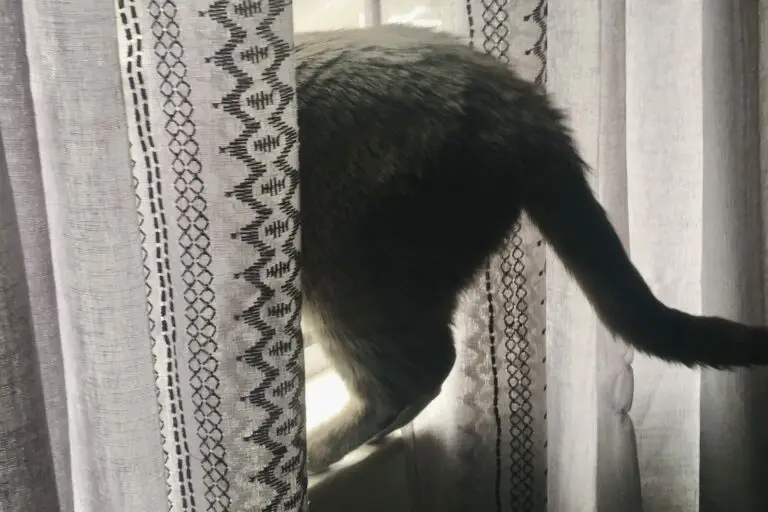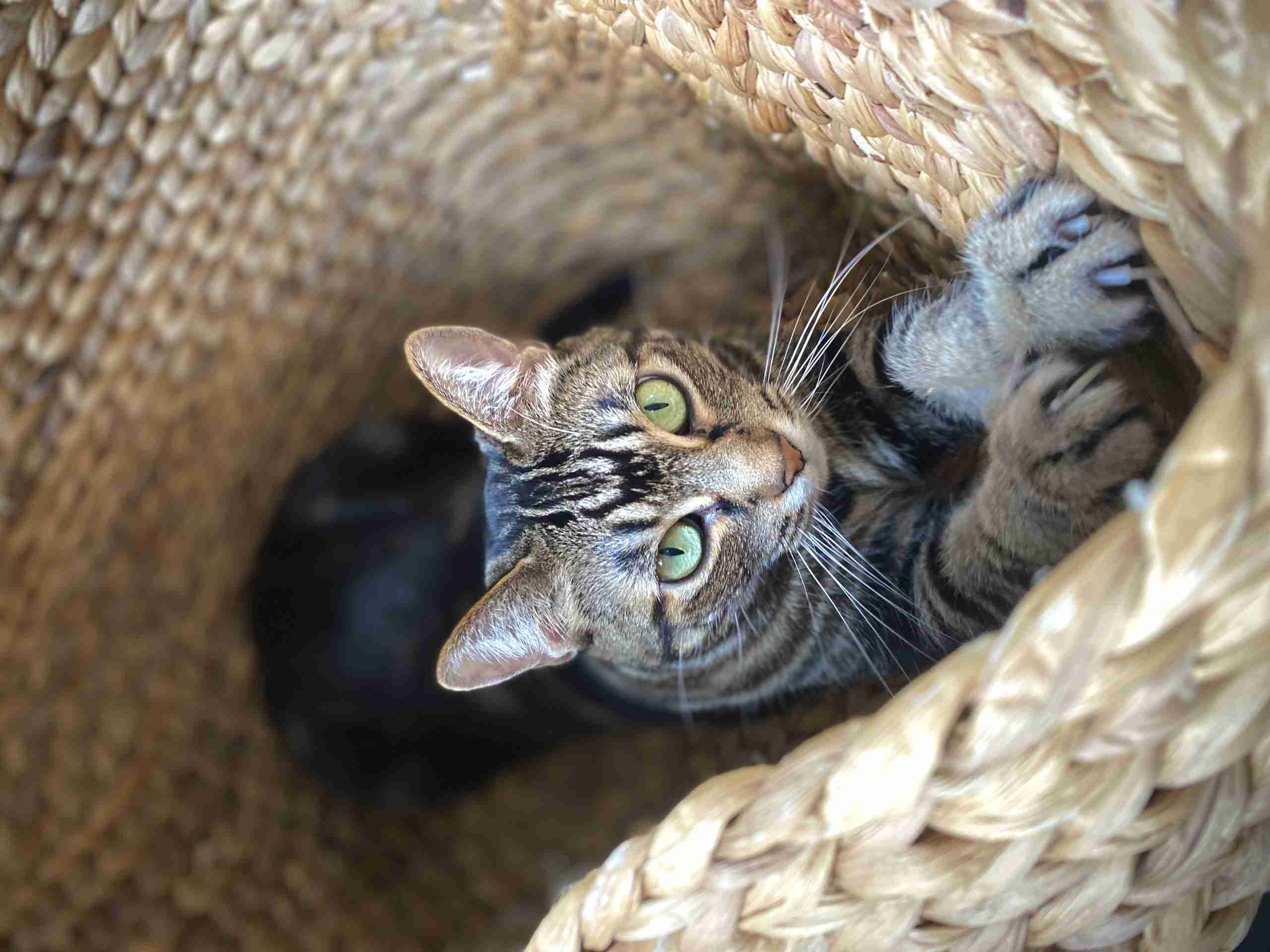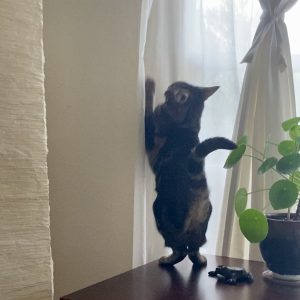How to Cat-Proof the Windows & Screens in Your Home
Windows that aren’t properly cat-proofed are just a setup for all kinds of disaster for cats. We’re talking escapes, falls, injuries, and expensive vet bills. Not to mention damaged screens and curtains.
So, how do you go about cat-proofing your windows? Here are the five areas you need to be on top of.
In this article, we’ll get into the details of those 5 areas, along with the 7 risks that windows pose to your cat. And for each area of risk, we also provide solutions to address them and keep your cat safe.
And if you’ve got a kitten or young cat, don’t miss the section at the end about considerations for kittens and screens.

Windows Are a Big Part of Indoor Cat Enrichment
Windows are valuable assets in the catification of your home. By setting up cat trees and perches near windows, you give your cat needed vertical space and stimulation.
The window is a place where they can nap in the sun, and scan the outdoors for prey with their eyes and noses. It helps keep their senses sharp.
But windows can pose real dangers to your cat if not properly cat-proofed and maintained.
Affiliate Disclosure: VerveCat is supported by readers. As a member of Amazon Associates and other affiliate programs, we may earn a commission at no added cost to you when you follow a product link and make a purchase.
7 Risks Windows Can Pose to Your Cat – and Solutions
In this section, we’ll go over the ways windows can be dangerous for cats, along with possible solutions in each area to reduce the risks.
1. Risk: Escape or fall from open windows with no screen
Open windows with no screens aren’t safe. Contrary to popular belief, cats don’t always land on their feet, and even if they do, falls can result in serious injuries or even be fatal.
High-rise syndrome, a term used to describe the injuries cats sustain from falls or jumps from high places, is a real concern. You must understand that even a fall from a second-story window or landing can do real damage to your cat.
Reality is, cats try stupid things sometimes, and they don’t always nail their jumps.
Solution
If there’s no secure screen installed, just keep that window securely latched shut. And make sure everyone in your home knows not to open that window.
2. Risk: Escape or fall due to unsecured, weak, or damaged screens
It’s easy to assume that because a window has a screen, your cat will be fine with that window open. But screens can be deceptive in terms of security.
Cats may lean on or claw at screens out of curiosity. They may even try to charge through a screen in an attempt to go after birds, squirrels, or another cat.
A loose or torn window screen is not a reliable safeguard against falls or escape. The weight of a cat can easily push out a screen that is not properly secured, leading to the same dangers as an open window.
My own experiences with loose screens – a tale of caution
I learned the hard way when I moved to a new house a couple years ago. One warm evening I left my screened window open for my cats to hang out in, but I didn’t check first to see how securely the screen was kept in place.
It turned out that the hardware keeping the screen in place was loose. When a curious neighbor cat came to the window, it led to a squabble with my cats through the screen.
Things escalated and Gandalf must have lunged or pushed on the screen, which fell completely out and two of my cats went tumbling out after.
I ran into the room to find them outside the house in the middle of a cat fight. Yikes! Lesson learned. (Sidenote: that same neighbor cat regularly comes and sprays my front door to mark his territory, so he’s not exactly my favorite)
Solutions
- Check every window screen. They need to be in good condition, installed correctly, and sturdy.
- When in doubt, just keep the window shut. The only guaranteed way to prevent screen incidents is a closed window.
- Don’t leave screened windows open for your cat when you’re not home.
- Secure your screens with anchors if needed. Always make sure a screen won’t fall out if your cat pushes or lunges hard against it.
- Repair or replace damaged screens.
- Replace weak or flimsy screens with stronger ones.
Simple Screen Anchor
I use an inexpensive hardware anchor like this one (Amazon) to secure my window screens. They’re very easy to install and can add real peace of mind.
Here’s what I use to secure my screens
This window is just to the left of my desk. It has a cat tree next to it for easy cat access. The photos show how the screen is secured.
The clip is anchored by a screw. It has a vertical edge on the outside of the screen, which holds the screen in place if pushed from the inside. (I need to replace that rusty screw!)


You might consider using two latches for each screen, spaced evenly, instead of just one in the center.
I am currently using one in the center but I am paranoid that Gandalf could squeeze through if he pushed hard with his head at one of the corners (must catch squirrel!).
3. Risk: Illness from transmissible disease exposure through close contact with feral cats
Even if you have secured your screens, there is always the chance that your cat could end up nose to nose with an animal on the outside.
One of the most likely of these kinds of encounters is one with another cat that may possibly be carrying a disease that can be passed through saliva.
Solution
If you want to make open window time a thing for your cat, keeping vaccinations up to date is an absolute must. (One of the many reasons to vaccinate your cat)
4. Risk: Injury from getting stuck climbing screens or curtains
A cat that takes a trip up your screen or curtain probably hasn’t thought through how to get back down. It’s also easy for claws to get stuck, especially in screens.
This can lead to awkward falls. And a stuck claw pulled out from a screen forcefully can lead to severe paw injury.
Solutions
- Provide vertical/climbing options near risk areas like tall curtains or sliding screen doors.
- Train your cat to use the cat stuff (e.g., cat tree and scratchers) in each room by reinforcing desired climbing and scratching behaviors.
- Never pull your cat down from a screen they’re climbing. You need to carefully lift them and their paws up and away from the screen in order to prevent injuring a stuck claw.
- Never punish your cat for climbing the “wrong” thing. If your cat climbs the screen or curtain, they’re just doing what cats are wired to do. It’s your job to catify your space, train your cat, and redirect unwanted behaviors.
- Consider options for cat-proofing curtains (how-to article).
5. Risk: Injury or strangulation from getting stuck in draw cords
If windows have blinds or curtains that are opened and closed using a cord or drawstring, a cat can quickly become entangled in it, risking serious injury or death from strangulation if the cord wraps around the neck.
The most dangerous is the kind of cord that forms a closed loop.
When cats become tangled or trapped in something, they often panic and thrash around trying to free themselves, which can make things go from bad to worse in an instant.
Solutions
1. Create a system for keeping the cords out of reach
One simple way of doing this is to gather the cord up in a bunch and fasten the bunch together with a clip, clothes pin, or strip of cloth to tie it.
Or you can wrap the cord around mounted hooks, like this one on Amazon.
This allows you to hang the cord higher and out of reach of a jumping cat. It might make it slightly less convenient for you to use, but it’s really a necessary compromise if you have shades with cords.
2. Use the best kind of cat-proof blinds
For real safety on this front, cordless blinds are the way. Here’s an example at Amazon.
3. Use shutters
Shutters can be another safer alternative to corded blinds. Not only are they cordless, but they can allow you to keep the window open even if the screen is missing or flimsy.
Just make absolutely sure your cat can’t get under, through, or around them when they’re shut.
6. Risk: Injury from a falling window frame
Some window frames that open by being pulled up are heavy and don’t stay open without being propped up by something. This can result in a window suddenly falling onto your cat who is stretched out for a cat nap in the sun.
Solutions
Fix the window or don’t open it.
If the window is like this because the mechanism that holds it open is broken, get it fixed before giving your cat access to it when it’s open.
Otherwise, just leave it shut and don’t take the risk of it falling on your cat. Don’t prop it open with something hoping it stays.
7. Risk: Escape or fall from windows that cats can push open
Some windows that easily slide open sideways or that push out to open can be opened by a cat if they aren’t latched and locked.
Solutions
- Always make sure the window is latched shut.
- Don’t leave it cracked open without a mechanism to hold it securely in that position.
- Use a window limiter, like these options (Amazon).
Complementing Cat-Proofing
And of course, cat-proofing alone isn’t enough. It goes paw-in-paw with catification and cat training.
This means optimizing the cat-friendliness of areas near windows, and reinforcing desired behaviors while redirecting undesired behaviors.
Special Considerations for Kittens and Screens
When it comes to screens and kittens, there are a few things you can do to help prevent climbing and the damage it causes.
First, take the time to catify the space near the window and door, and cat-proof the window itself. This should be done before you even bring a kitten home, but if not, it’s not too late.
Then, the main strategy is to train your kitten over time to use the cat stuff (cat trees, scratchers, etc), while at the same time never letting them have unsupervised access to the exposed screen. It’s really hard to keep a kitten from climbing a screen when it’s right there in front of them.
After a few months, your adolescent cat will be both a little calmer and accustomed to meeting climbing needs by climbing the cat tree and other vertical spaces you provide.
At this point, you can introduce closely supervised access to the screen. If your cat is still very tempted by it, go back to the original plan for another month or two, then try again.
The aim is to get to a place where your cat just automatically uses your catified stuff and the temptation of climbing the screen is gone. Once you’re there, continue to reinforce the desired climbing behaviors, and quickly redirect any interest in the screen back to the cat tree or scratcher.
In the early phases of this project, if you really need to have the window open and it’s too difficult to supervise closely enough, just put the kitten in a separate cat-safe room until you’ve shut the window again.
Final Thoughts
There are so many potential dangers to your cat around windows, so don’t sleep on the cat-proofing.
Whatever systems you come up with, make sure you get everyone in the house on the same page. And include that information in the cat care guide you give to cat sitters.

